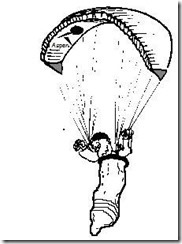Landing Direction
We all know which way to land, don’t we? Into wind, of course. I got a timely reminder recently of how important it is to keep monitoring the wind direction during a flight. The LCC was on Blease Fell, forecast was a light SSW. Very light at first, which had me and Jim thinking triangles as we weren’t in the comp, but after trying to penetrate into wind, that clearly wasn’t going to happen without switching to a Zeno. As the speed picked up, there were reports of pilots getting blown into awkward situations, and some elected to abort the task early and land in the football field.
I left the summit of Blencathra at base, well above any turbulence and there was a great looking cloudstreet over Carrock and on towards Carlisle, confirming the forecast direction veering to SW later. The blue sky showed a sea breeze pushing in from the west, over the Solway Firth, so I was dog-legging away from the coast, eventually turning east to follow the A69 Carlisle-Newcastle road, belting along at 60 km/hr. All good, and all so predictable.
Serious turbulence and a big change in the thermal consistency showed something had changed, and I opted to land at Low Row where I had a chance of hitching a lift. When I set up for a landing out, I build a picture in my head of the terrain, the wind direction and strength, trying to visualise what I might encounter and planning the best approach. Fortunately, I had plenty of height: after my first circle above my chosen field, I had to do another one as I couldn’t reconcile what I could see happening, and what my instruments told me, with my mental image. The wind was 180 degrees wrong – blowing from the East, and strong! No drama, plenty of room to adjust my approach, but I could have had a nasty surprise trying to land into the wind I thought was there. The presence of layers of wind in opposite directions also explains the violent turbulence earlier, but I saw nothing in any forecast predicting an easterly wind in that location. So the moral of the story is to always keep monitoring the conditions, especially when moving into different terrain.
Tight lines.
Brian
